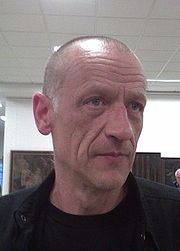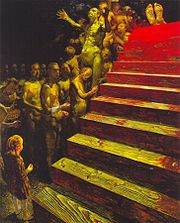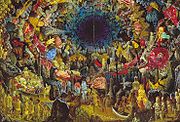
Šarunas Sauka
Encyclopedia



Šarūnas Sauka (born 1958 in Vilnius
Vilnius
Vilnius is the capital of Lithuania, and its largest city, with a population of 560,190 as of 2010. It is the seat of the Vilnius city municipality and of the Vilnius district municipality. It is also the capital of Vilnius County...
, Lithuanian SSR
Lithuanian SSR
The Lithuanian Soviet Socialist Republic , also known as the Lithuanian SSR, was one of the republics that made up the former Soviet Union...
, Soviet Union
Soviet Union
The Soviet Union , officially the Union of Soviet Socialist Republics , was a constitutionally socialist state that existed in Eurasia between 1922 and 1991....
) is a Lithuania
Lithuania
Lithuania , officially the Republic of Lithuania is a country in Northern Europe, the biggest of the three Baltic states. It is situated along the southeastern shore of the Baltic Sea, whereby to the west lie Sweden and Denmark...
n postmodern painter. His father is an eminent Lithuanian philologist Donatas Sauka. In 1989 he was awarded Lithuanian National Prize
Lithuanian National Prize
The Lithuanian National Prize , established in 1989, is an award granted for achievements in culture and the arts. It has been awarded annually in six categories since 2006...
.
From 1976 to 1983, Šarūnas Sauka studied at the National Institute of Lithuania, Vilnius Art Academy. In 1989, the artist was nominated for the Lithuania National Award for diptych
Diptych
A diptych di "two" + ptychē "fold") is any object with two flat plates attached at a hinge. Devices of this form were quite popular in the ancient world, wax tablets being coated with wax on inner faces, for recording notes and for measuring time and direction.In Late Antiquity, ivory diptychs with...
"Žalgirio mūšis" (English: Battle of Grunwald
Battle of Grunwald
The Battle of Grunwald or 1st Battle of Tannenberg was fought on 15 July 1410, during the Polish–Lithuanian–Teutonic War. The alliance of the Kingdom of Poland and the Grand Duchy of Lithuania, led respectively by King Jogaila and Grand Duke Vytautas , decisively defeated the Teutonic Knights, led...
). Sauka now lives in Dusetos
Dusetos
Dusetos is a city in Zarasai district municipality, northeastern Lithuania, west of Zarasai, near Lake Sartai.-Name:Dusetos is the Lithuanian name of the city. Versions of the name in other languages include Polish: Dusiaty, Russian: Дусяты Dusiaty, Belarusian: Дусяты Dusiaty, Yiddish: דוסיאַט...
, a small and remote village among numerous lakes and forests.
Sauka believes that the human spirit must be stripped from conventional chains in order to contemplate the true condition of its body and soul. A full appreciation of his artwork requires an understanding of the extent and cruelty of the communist terror in Lithuania and other countries of Eastern Europe
Eastern Europe
Eastern Europe is the eastern part of Europe. The term has widely disparate geopolitical, geographical, cultural and socioeconomic readings, which makes it highly context-dependent and even volatile, and there are "almost as many definitions of Eastern Europe as there are scholars of the region"...
and a grasp of some of the underlying metaphysical and archetypal ideas that are basic to his world view and sensibility.
Šarūnas Sauka is considered to be one of the most significant postmodernist
Postmodernism
Postmodernism is a philosophical movement evolved in reaction to modernism, the tendency in contemporary culture to accept only objective truth and to be inherently suspicious towards a global cultural narrative or meta-narrative. Postmodernist thought is an intentional departure from the...
painters in Lithuania. His work is often referred to as "different". However, the "difference" in Sauka's paintings is quite consistent, because he usually uses his own face, sometimes faces of his family members or relatives. In many of his paintings, the victim and aggressor both have the same face.
- "The scope of Sauka's imagination includes various manifestations of corruption, rotting, and deterioration, usually connected with human corporeality understood as the antithesis to the Christian ideal of redemption and that of corporeal resurrection. Here we meet horror—struck Gnoticism mixed with Postmodern irony. The artist's world is not a theophany, but a place of Gnostic terror, abandonment and submission to malign forces. However, the labyrinth of material darkness is also a vessel where alchemical work can be done, while supported by the creative imagination. Hence, pathology is inherently mythologized, just as all mythology is pathologized. Sauka stands against both the dematerialization and the spiritualization of reality. He partly follows the tradition of classical European painting, especially as regards various techniques and principles of expression, though creating quite a different context where any traces of Aristotelian logic vanish and the forces of evil become permanent and irrefutable. In a sense, Sauka not only symbolizes the gloomy end of Christian civilization and its methphysics, but also reveals the foolish face of the 20th century, which appears when the masks of rationality and seeming wisdom are stripped away." (Algis Uždavinys, Dr. of Philosophy)

